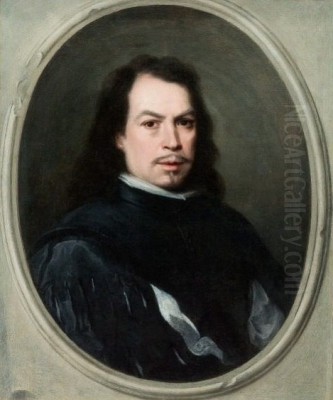
Bartolomé Esteban Murillo stands as one of the towering figures of the Spanish Golden Age, a painter whose works captured the profound religious piety and the vibrant street life of 17th-century Seville. Flourishing during the Baroque period, Murillo developed a distinctive style characterized by soft light, gentle emotionality, and a warm, inviting palette. While renowned primarily for his deeply moving religious canvases, particularly his numerous depictions of the Immaculate Conception and tender portrayals of the Virgin and Child, he was also a keen observer of his contemporary world, creating memorable genre scenes featuring the everyday lives of children and the less fortunate. His art, born from the specific cultural milieu of Andalusia, achieved immense popularity during his lifetime and exerted a significant influence on European painting for centuries that followed.
Early Life and Artistic Formation in Seville
Bartolomé Esteban Murillo was born in Seville, likely baptized on the last day of 1617 or the first day of 1618 (the exact birth date is unknown, but his baptism was recorded on January 1, 1618). Seville at this time was a major cosmopolitan hub, a center of trade, culture, and intense religious activity, still benefiting from its role in trade with the Americas, though beginning a slow decline. Murillo came from relatively modest beginnings. His father, Gaspar Esteban, was a barber-surgeon, a respected trade but not one associated with wealth. His mother was María Pérez Murillo, and Bartolomé would later adopt her surname, a common practice in Andalusia.
Tragedy struck Murillo's early life. He lost his father when he was about nine or ten years old, and his mother passed away shortly thereafter, leaving him an orphan. He was subsequently taken in and raised by his older sister, Ana, and her husband, Juan Agustín de Lagares, who was also a barber-surgeon. This early experience of loss may have contributed to the sensitivity and emotional depth often perceived in his later works, particularly those dealing with themes of compassion, charity, and the vulnerability of childhood.
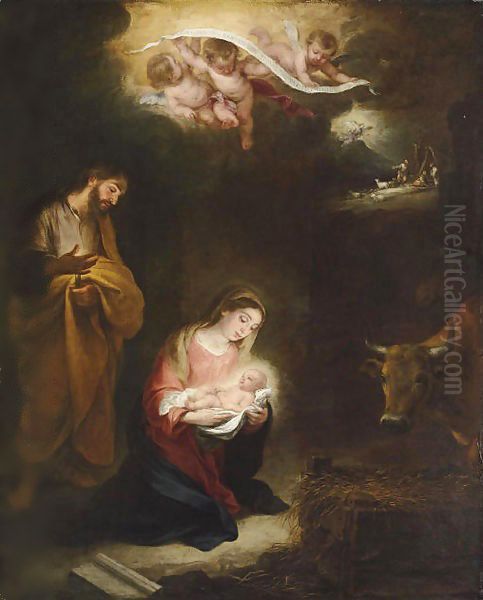
His artistic inclinations must have become apparent early on. Around the age of twelve, Murillo began his formal training as a painter. His first significant master was Juan del Castillo, a local Seville artist whose style was somewhat conservative, influenced by Italian Renaissance and Mannerist traditions filtered through Flemish prints. Castillo was related to Murillo through marriage and provided the young apprentice with a solid grounding in drawing and painting techniques. During this period, Murillo would have learned the fundamentals of composition, anatomy, and the preparation of pigments and canvases, likely copying prints and existing paintings as was standard practice. Some sources also suggest a possible, though less documented, period of study with the Flemish-influenced painter Pedro de Moya, which might have exposed him to different technical approaches, particularly regarding color and brushwork, hinting at the Northern European influences that would later surface in his mature style.
A Pivotal Journey and Early Career
A crucial, though somewhat debated, period in Murillo's development involves a potential trip to Madrid around 1642. While direct documentary evidence is scarce, tradition holds that Murillo traveled to the capital, possibly seeking broader artistic horizons or patronage. If this journey occurred, it would have been transformative. In Madrid, he could have encountered the works of the great court painter Diego Velázquez, a fellow Sevillian who had achieved unparalleled success. Exposure to Velázquez's sophisticated naturalism, masterful handling of light and texture, and psychologically insightful portraits would have been profoundly influential.
Furthermore, the royal collections in Madrid housed masterpieces by Italian Renaissance and Baroque artists like Titian, Veronese, and the Carracci, as well as Flemish masters such as Peter Paul Rubens and Anthony van Dyck. Seeing these works firsthand would have dramatically expanded Murillo's artistic vocabulary, particularly regarding color, dynamic composition, and the depiction of rich fabrics and varied textures. Even if he did not study directly under Velázquez, the mere immersion in the artistic environment of the court would have provided invaluable lessons, pushing him beyond the more provincial style of his initial training in Seville. This exposure likely played a role in the refinement of his technique and the broadening of his stylistic range upon his return.
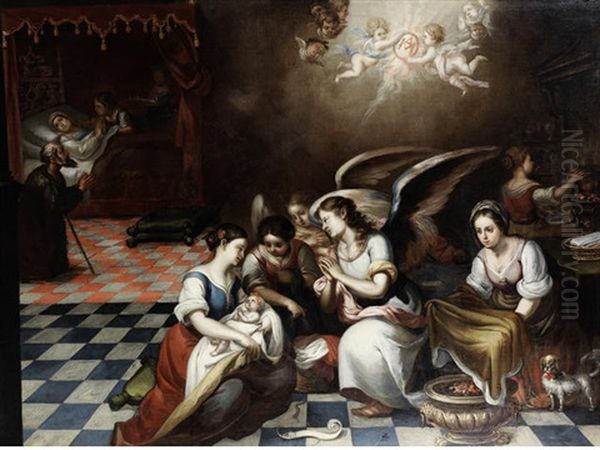
By 1645, Murillo was back in Seville, ready to establish himself as an independent master. His breakthrough commission came that year: a series of eleven large canvases for the cloister of the Franciscan monastery, the Convento de San Francisco el Grande. This significant project, depicting miracles and stories associated with Franciscan saints, immediately announced his arrival on the Sevillian art scene. Works from this series, such as The Angels' Kitchen (also known as The Miracle of San Diego de Alcalá), showcased his growing ability to handle complex narratives, manage large figure groups, and infuse scenes with both convincing naturalism and spiritual resonance. The success of the Franciscan cycle cemented his reputation, leading to a steady stream of commissions from churches, religious orders, and private patrons throughout Seville. He quickly became one of the city's most sought-after painters, rivaling established figures like Francisco de Zurbarán, whose starker, more austere style offered a contrast to Murillo's developing warmth.
The Evolution of Murillo's Style: The "Estilo Vaporoso"
Murillo's artistic style underwent a noticeable evolution throughout his career. His early works, influenced by Juan del Castillo and potentially the tenebrism (dramatic use of light and shadow) of artists like Jusepe de Ribera (though likely known more through prints or followers in Seville), often featured stronger contrasts, more defined outlines, and a somewhat earthier palette. This initial phase is sometimes referred to by the term "estilo frío" (cold style), characterized by its clarity and solid forms.
However, beginning in the 1650s and solidifying in the 1660s and 1670s, Murillo developed his signature manner, often called the "estilo vaporoso" (vaporous or hazy style). This mature style is marked by a softening of contours, a more fluid and delicate brushwork, and a luminous, often warm and golden, atmosphere. He masterfully employed sfumato, the subtle blurring of edges to create a hazy effect, which lent his figures a gentle grace and integrated them seamlessly into their surroundings. His palette became richer and more varied, incorporating silvery blues, soft pinks, golden yellows, and deep reds, applied with a lightness that enhanced the ethereal quality of his religious subjects.
This stylistic shift reflects a synthesis of various influences. The rich colorism owes a debt to Flemish painters like Rubens and Van Dyck, whose works he likely knew through originals or copies. The compositional grace and emotional tenderness can be linked to Italian High Renaissance masters such as Raphael and Correggio, and later Bolognese painters like Guido Reni. Yet, Murillo forged these elements into something uniquely his own. His "vaporous" style was perfectly suited to conveying the mystical visions, divine tenderness, and gentle piety that were central themes in Counter-Reformation spirituality, particularly as it manifested in Seville. It was less about dramatic intensity (like Caravaggio or Ribera) and more about approachable, heartfelt devotion.
Masterpieces of Religious Devotion
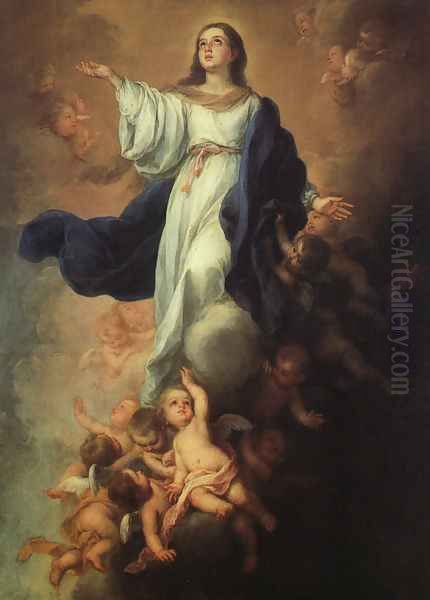
Religion was the cornerstone of Murillo's artistic output, reflecting the deeply Catholic culture of 17th-century Spain. He painted numerous altarpieces, devotional images for private chapels, and large narrative cycles for churches and confraternities. His interpretations of religious themes were characterized by their accessibility, emotional warmth, and idealized beauty, making complex theological concepts relatable to the faithful.
Among his most celebrated religious subjects is the Immaculate Conception, a doctrine particularly cherished in Seville long before its official papal definition. Murillo painted this theme perhaps more than twenty times, establishing an iconographic formula that became immensely popular and influential. Typically, he depicts the young Virgin Mary suspended among clouds, gazing heavenward with a serene or ecstatic expression, hands folded in prayer or crossed over her breast. She is often surrounded by playful cherubs (putti) and stands on a crescent moon, referencing the Woman of the Apocalypse. Notable versions reside in the Prado Museum (Madrid), the Louvre (Paris), and the Museo de Bellas Artes of Seville. Each version, while adhering to the basic formula, showcases variations in pose, color, and atmospheric effect, demonstrating his continuous exploration of the theme. His Immaculate Conception of Los Venerables (Prado Museum) is often considered the pinnacle of this series, admired for its dynamic composition, luminous color, and palpable sense of divine grace.
Murillo also excelled in depicting the Holy Family and scenes from the life of Christ and the Virgin Mary. His paintings of the Virgin and Child are renowned for their tender intimacy, portraying Mary not as a remote queen of heaven, but as a loving, gentle mother. Works like The Virgin and Child with Saint John the Baptist (often called The Children of the Shell) emphasize the humanity and approachability of the holy figures. The Annunciation, The Birth of the Virgin (Louvre), and the Assumption of the Virgin (various versions) are other key works where his "estilo vaporoso," with its soft light and delicate colors, enhances the sense of divine miracle and spiritual elevation.

He also painted numerous saints, often focusing on moments of ecstasy, charity, or martyrdom. Early works like St. Leander and St. Isidoro for Seville Cathedral show a powerful monumentality. Later works, such as the Vision of St. Anthony (Seville Cathedral), where the Christ Child descends into the arms of the praying saint, combine intense spiritual fervor with his characteristic gentle style. His series for the Hospital de la Caridad in Seville, including Moses Striking the Rock and The Miracle of the Loaves and Fishes, are large-scale narrative works emphasizing themes of charity and divine providence, commissioned by the philanthropist Miguel Mañara. The Marriage of St. Catherine, painted for the Capuchin monastery in Cádiz, was tragically the work he was completing when he fell from scaffolding, an accident that likely led to his death.
Genre Paintings: A Window into Sevillian Life
While primarily a religious painter, Murillo also produced a significant body of genre paintings, offering invaluable glimpses into the everyday life of 17th-century Seville, particularly the lives of its poorer inhabitants and children. These works were highly popular, especially with Flemish merchants residing in Seville, and contributed significantly to his fame abroad.
His depictions of street urchins, often referred to as niños pícaros (roguish children), are among his most iconic secular works. Paintings like The Young Beggar (Louvre), Children Eating Grapes and Melon (Alte Pinakothek, Munich), and Two Children Eating a Pie capture the resilience, charm, and hardship of children living on the margins of society. Unlike the stark realism sometimes found in the works of earlier painters of low-life scenes, Murillo often imbued these children with a sense of dignity and an endearing charm, even amidst their poverty. Their ragged clothes and humble settings are depicted with meticulous detail, yet the overall mood is often softened by warm light and the engaging expressions of the children themselves.
These genre scenes have sparked debate among art historians. Some see them as sentimentalized portrayals that gloss over the harsh realities of poverty in plague-ridden, economically struggling Seville. Others view them as sympathetic observations that reflect Counter-Reformation ideals of charity and the inherent worth of every soul, regardless of social standing. Regardless of interpretation, these paintings demonstrate Murillo's keen powers of observation and his ability to capture fleeting moments of childhood innocence and camaraderie. Works like Girl and Her Duenna (National Gallery of Art, Washington D.C.), also known as Two Women at a Window, show his skill in depicting contemporary figures and subtle psychological interactions within a genre context. These secular paintings provide a crucial counterpoint to his religious works, showcasing the breadth of his artistic interests and his connection to the world around him.
Portraiture and Narrative Cycles
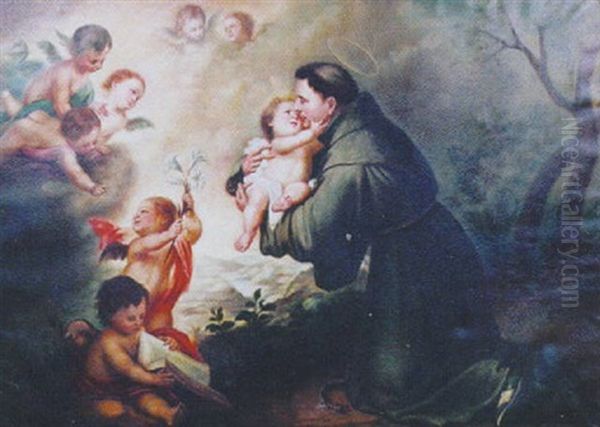
Although less numerous than his religious or genre paintings, Murillo also undertook portrait commissions. His portraits, like his other works, are characterized by a naturalness and psychological sensitivity. He often employed the soft lighting and fluid brushwork of his "estilo vaporoso" to create likenesses that feel alive and approachable. Notable examples include the Portrait of Don Andrés de Andrade y la Colcha (Metropolitan Museum of Art, New York), which conveys the sitter's status and personality with quiet dignity. Another significant work often cited is the Portrait of a Knight of Santiago, possibly depicting Don Antonio Hurtado de Salcedo (Prado Museum), which combines formal representation with Murillo's characteristic warmth. His self-portraits, particularly the later one now in the National Gallery, London, offer introspective glimpses of the artist himself.
A unique undertaking in Murillo's oeuvre is the narrative cycle of the Parable of the Prodigal Son, a series of six paintings currently housed in the National Gallery of Ireland. This is the only known narrative cycle of its kind by the artist. Executed likely in the 1660s, the series unfolds the biblical story with dramatic flair and rich detail, showcasing Murillo's ability to handle sequential storytelling. From the son receiving his inheritance to his dissolute living, subsequent destitution, and eventual repentant return and forgiveness, Murillo captures the emotional arc of the parable. The scenes are filled with lively details of contemporary life, costumes, and settings, blending biblical narrative with observations drawn from his own time. This series stands as a testament to his versatility and his skill in conveying complex human emotions through visual narrative.
The Seville Academy and Murillo's Legacy
Beyond his prolific output as a painter, Murillo played an important role in the artistic life of Seville through his involvement in education. In 1660, recognizing the need for a formal institution to train artists and elevate the status of painting, Murillo, along with fellow painter Francisco Herrera the Younger, was instrumental in founding the Academia de Bellas Artes (Academy of Fine Arts) in Seville. This was one of the earliest such institutions in Spain. Murillo served as its first president, demonstrating his commitment to fostering artistic talent and promoting professional standards.
The Academy provided structured training, emphasizing drawing from life and the study of anatomy, moving beyond the traditional workshop apprenticeship system. Although his presidency was relatively brief, his initiative laid the groundwork for future generations of artists in Seville. His own workshop was large and productive, training numerous pupils and assistants who helped disseminate his style. His influence extended beyond his direct students, as his works became models for countless artists in Spain and across Europe.
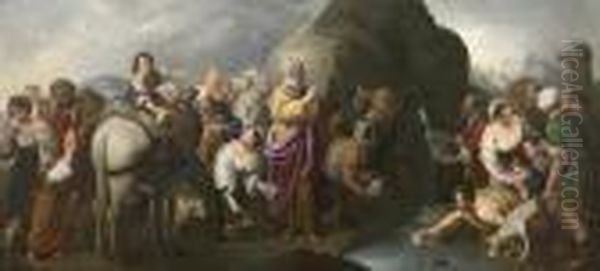
Murillo's fame, already substantial during his lifetime, continued to grow after his death in Seville in April 1682, following complications from the fall he suffered while working in Cádiz. Throughout the 18th century, his reputation soared, particularly outside Spain. His gentle piety appealed to the sensibilities of the Rococo era, and his genre scenes were highly prized by collectors. Artists like the French painters Jean-Honoré Fragonard and Jean-Baptiste Greuze admired his tender depictions of children and everyday life. In England, his works were avidly collected, and painters such as Thomas Gainsborough and Sir Joshua Reynolds drew inspiration from his fluid brushwork, warm colors, and graceful compositions. For a time, Murillo's international reputation arguably surpassed even that of Velázquez.
Fluctuating Reputation and Historical Evaluation
The 19th century witnessed a shift in Murillo's critical fortunes. With the rise of Romanticism and later Realism, artistic tastes began to favor more dramatic, heroic, or socially critical themes. Murillo's perceived "sweetness" and idealized portrayals, once admired, came to be seen by some critics as sentimental, lacking in strength, or superficial, especially when compared to the perceived gravity of Velázquez or the stark intensity of Zurbarán or Ribera. His immense popularity led to countless copies and imitations, many of subpar quality, which further diluted the appreciation of his genuine achievements.
However, the 20th century brought a more balanced reassessment of his work. Art historians began to look beyond the sometimes saccharine interpretations and recognize the technical brilliance, compositional sophistication, and genuine emotional depth present in his best paintings. His mastery of light and color, the subtlety of his characterizations, and his significant role within the context of Spanish Baroque art and Counter-Reformation culture were re-evaluated. Exhibitions and scholarly studies shed new light on the diversity of his output and the complexities of his style.
Today, Murillo is firmly recognized as one of the essential masters of the Spanish Golden Age. While Velázquez may hold the title of the era's supreme genius for his profound naturalism and technical innovation, Murillo remains celebrated for his unique ability to blend the divine and the human, the spiritual and the everyday, with unparalleled grace and tenderness. His works continue to resonate with viewers for their beauty, their emotional accessibility, and their enduring portrayal of faith and humanity. His paintings are prominently displayed in major museums worldwide, including the Prado Museum, the Louvre, the National Gallery in London, the Hermitage Museum, and numerous collections across the Americas, ensuring his legacy endures.
Conclusion: The Enduring Appeal of Murillo
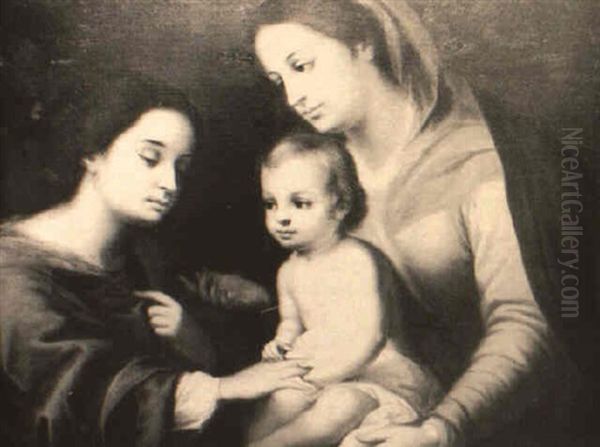
Bartolomé Esteban Murillo's art represents a culmination of the Seville school of painting and a high point of the Spanish Baroque. Emerging from a city rich in cultural and religious fervor, he developed a style that perfectly captured the spirit of his time and place. His religious paintings offered solace and inspiration through their gentle piety and idealized beauty, making the divine seem approachable and compassionate. His genre scenes provided a unique and often charming perspective on the everyday lives of ordinary Sevillians, particularly children, rendered with keen observation and technical skill.
Through his mastery of the "estilo vaporoso," with its soft light, fluid brushwork, and warm colors, Murillo created images of enduring appeal. He successfully synthesized influences from Italian and Flemish art while forging a deeply personal and recognizable style. His role in founding the Seville Academy highlights his commitment to the artistic community. Though his critical reputation has fluctuated over the centuries, his status as a major figure in European art history is now secure. Murillo's paintings continue to captivate audiences with their technical brilliance, emotional resonance, and timeless depictions of faith, charity, and the simple moments of human existence, securing his place alongside Velázquez, Zurbarán, and Ribera in the pantheon of Spanish masters.